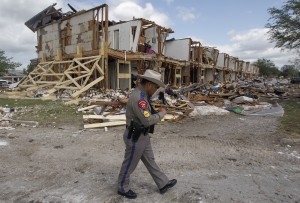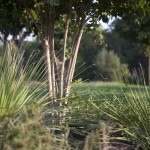After West Fertilizer Explosion, Concerns Over Safety, Regulation and Zoning

Photo by Ron Jenkins/Fort Worth Star-Telegram/MCT
A flag is flown at half staff in West, Texas, near the scene of the fertilizer plant that exploded Wednesday night in in the town of 2,8000 on Thursday, April 18, 2013.
It will take time to determine the exact cause of the fire and explosion at the fertilizer plant in West, Texas. The disaster has cost at least 14 lives, caused 200 injuries and has destroyed at least 50 homes. The blast was so strong that it blew out windows for miles, and even registered as an earthquake. First responders said the aftermath looked like “a war zone.”
Yet even at this early stage of the investigation, there are signs that not all was right with the plant, like the fact that it had as much as 270 tons of ammonium nitrate (which can be explosive) at the site, but no sprinklers or fire barriers. It’s also brought up questions about regulation in Texas, and whether homes and schools should be so close to industry. (State fire officials have said that there are no signs of criminal activity so far in the West explosion.)
‘Everybody Plays Over There’
For residents in this small community of 2,800 known for its Czech heritage, the West Fertilizer plant had been a mostly decent neighbor. After all, the West Intermediate School was right next to it.
“Everybody plays over there,” resident Deborah Waters tells StateImpact Texas. “That track that is right beside the intermediate school, normally at that time of day, there are 20 to 30 people walking the track.”

Photo by REUTERS /POOL/LANDOV
Texas Department of Public Safety Sergeant Jason Reyes walks past the site of an apartment complex destroyed by the deadly fertilizer plant explosion in West.
“I think most people didn’t even think about it being there, for the most part,” Waters says.
But there were times when they thought about it – like when they could smell ammonia coming from the plant.
“There were times when I was growing up as a kid that there would be ammonia smells,” says Loretta Volcik, who has lived in West her whole life. She works at Baylor University, where she’s also getting her degree. “You know, you’d be playing outside, and your eyes would start watering. And it was like, ‘Uh oh, fertilizer plant! Time to go in!”
Missing Permits and Incomplete Reports
One such complaint about those smells triggered an investigation by the Texas Commission on Environmental Quality (TCEQ) in 2006. But it wasn’t a swift response.
“It took the agency 11 days to come out. That’s too long of a time frame,” says Elena Craft, a toxicologist with the Environmental Defense Fund. “When we have information such that there was a smell of ammonia, that it was coming from a fertilizer plant, that’s a high priority.”
While investigators were there, they found the company had been operating for two years without a necessary air quality permit. Once the company got that permit, the TCEQ never went back. The Commission doesn’t generally pay a visit to facilities like the one in West unless someone complains.
“Historically, fertilizer plants have not been given the level of attention of scrutiny that other industrial or petrochemical facilities have received,” Craft says.
The plant was also regulated by other state and federal agencies, a gallimaufry of acronyms like PHMSA, OSHA, DSHS, and others, but there appears to have been little communication and coordination among them.
For instance, West Fertilizer was required to file a worst case scenario risk management plan with the Environmental Protection Agency (EPA), says Kelly Haragan, Director of the Environmental Law Clinic at the University of Texas at Austin School of Law.
That report outlines the possible public safety issues at a facility like West Fertilizer. (The facility was fined by the EPA in 2006 for not having a risk management plan in place, according to several press reports.)
In its report to the EPA in 2011, West Fertilizer said its worst-case scenario was a release of one of its storage tanks of anhydrous ammonia “as a gas over 10 minutes.” It said nothing of fire risk. It also said nothing of ammonium nitrate at the site.
But according to records from the Texas Department of State Health Services obtained by StateImpact Texas, the plant had as much as 270 tons of ammonium nitrate at the site in 2012. To put that in perspective, the bombing of a federal building in Oklahoma City on April 19, 1995, which killed 168 and injured hundreds, used 4,800 pounds of ammonium nitrate mixed with other chemicals and diesel fuel, or about 2.4 tons.
In their disclosure to the state, West Fertilizer noted a fire risk from the pure solid ammonium nitrate, but said there was no fire risk from the anhydrous ammonia. While the company had filed reports with the department for years, 2012 was the first year they said they had ammonium nitrate, according to the agency.
These risk management plans are supposed to be shared with local officials and emergency responders, but that’s not always the case, Haragan says. And if you’re trying to get your hands on one as a local citizen, it can be a difficult task.
“Those reports are kept pretty tightly controlled,” Haragan says. “You have to go to a federal reading room to see them. You can’t make copies of them. You can bring in a pad of paper and a pencil. and that’s it.”
The plant was also fined $5,250 by the Pipeline and Hazardous Materials Safety Administration (PHMSA) in 2012 for improper labeling of storage tanks and “failing to develop and adhere to a security plan.”

Photo by Filipa Rodrigues/KUT News
Daryl Garrick and his brother board up his damaged home. Garrick says the plant had been burning wood pallets recently, which locals had complained about.
And there are concerning reports that the plant was burning wood pallets in recent months.
In February, the West Intermediate School was evacuated because of one of those fires. The school wasn’t notified of the burn ahead of time, Superintendent Marty Crawford said in a letter to parents and staff.
It’s unclear if the pallet burns could be a cause of Wednesday’s fire and explosion, but local Daryl Garrick says the fires had been the subject of complaints recently in West.
Garrick says the explosion Wednesday knocked him four feet in the air off his couch. He lives about a mile away from the plant, and his grandchildren were in the apartment building next to West Fertilizer at the time of the explosion that was destroyed. He says they’re okay, but sustained injuries.
First Responders Face Great Risks
Another issue drawing scrutiny after the West explosion is how well trained local first responders are to deal with fires and accidents at major industrial facilities.
In 2011, a fire started at the Magnablend chemical plant in Waxahachie. Locals had to be evacuated. But first responders didn’t know what chemicals were inside or that the building didn’t have adequate sprinklers.
“They should know,” says Craft of the Environmental Defense Fund. “Because what happens is, you may alter the way that you handle that situation. And I think that these deaths can be avoided.”
As the drilling boom continues to spread across the state, impacting quiet Texas towns, first responders are also being asked to go into situations where they may not know the full dangers.
An explosion at a drilling wastewater disposal well in Pearsall last January was one such incident. Workers were welding a storage tank when sparks caused an explosion at an adjacent tank, injuring three.
The fire burned for over an hour, and the all-volunteer Pearsall Fire Department (and three other nearby departments) had to fight the flames with twelve trucks and 33 firefighters. The company was later cited by the Occupational Safety and Health Administration (OSHA) for ten “serious” violations and fined the company behind the well $46,200.
After the fire started in West on Wednesday, volunteer firefighters (one of whom works at the fertilizer plant) rushed to the blaze. Of the fourteen confirmed fatalities in West, most were firefighters and first responders.
Across Texas, Communities Living Next Door to Industry
Yet another question after the explosion is whether or not industrial facilities should be right next door to schools and residences like the one in West.
“In Texas, counties have almost no regulatory authority,” Haragan of UT Law says. “And we kind of don’t like land use [policies] in Texas. So we’ve ended up where facilities are very close to people.”
Haragan says that regardless of the cause of the West explosion, there’s one thing that could’ve been prevented: the plant’s proximity to homes and schools, which were built after the plant.

Photo by REUTERS/Adrees Latif
An aerial view shows investigators walking through the aftermath of a massive explosion at a fertilizer plant in the town of West, near Waco, Texas April 18, 2013.
“You hope that we can implement some changes, so we don’t have to wait until a plant explodes and people are killed, before you come in and try to do what just seems like common sense: people shouldn’t be living so close to some of these industrial facilities,” Haragan says.
When asked at a press conference Friday if the state should be doing more to regulate and properly zone industrial facilities, Governor Rick Perry said he’d look into it.
“Listen, if there’s a better way to do this, we want to know about it,” Perry told reporters. “If there’s a better way to deal with these events, we want to have that discussion, whatever that might be.”
The owner of the plant, Donald Adair, who lives in West, said in a statement Friday that his “heart is broken with grief for the tragic losses to so many families in our community” but did not issue a formal apology. “This tragedy will continue to hurt deeply for generations to come,” Adair said, adding that his company pledges “to do everything we can to understand what happened to ensure nothing like this ever happens again in any community.”
Business-Friendly State Struggles With Safety

Photo by REUTERS /ADREES LATIF/LANDOV
First Baptist Church Pastor John Crowder leads an open air Sunday service four days after the deadly blast.
Elena Craft says the West disaster is likely to be one of the deadliest industrial accidents in decades in Texas, but that incidents like these tend to be preventable.
Texas leads the nation in workplace fatalities, with 433 deaths in 2011. That’s nearly a hundred more than California, which has six million more people in its workforce.
“You know, we’ve always touted Texas as a place open for business,” Craft says. “The fact is, our jobs should not cost us our life. And that’s what we’ve seen throughout the history of Texas.”
The investigation into the West Fertilizer fire continues. A memorial service for the fallen firefighters and first responders will be held Thursday, April 25 at 2 p.m. at the Ferrell Center at Baylor University in Waco.


